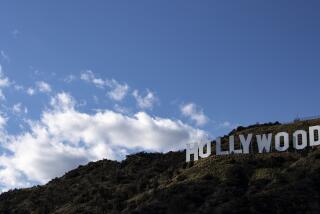CALIFORNIA ALBUM : There’s Gold in Them Thar Hills Again : Scenic Lone Pine and its Alabama Hills are experiencing a resurgence in popularity among makers of movies and commercials.
- Share via
LONE PINE, Calif. — Almost at the dawn of Hollywood movie making, this little Eastern Sierra town became a favorite outpost for location filming. It offered scenery ranging from Sierra peaks to sand dunes and was used in hundreds of feature films, serials and B movies, most of them Westerns.
Movie cowboys from Tom Mix and Hoot Gibson to Gene Autry and Hopalong Cassidy chased innumerable bad guys in the hills around Lone Pine. Between the 1930s and the early 1950s it was common to find stars such as John Wayne, Gary Cooper and Errol Flynn walking the main street.
When Westerns fell out of favor and costs for filming 200 miles from Hollywood became prohibitive, the stream of movie crews all but dried up. For Lone Pine, which had evolved from a mining community and came to depend mainly on tourism and the location crews, hard times came.
The population shrank and many of the cafes and other businesses along U.S. 395, the main street, closed. Location crews still drifted in to shoot an occasional television episode or commercial, but the drop-off was painful.
In the last few years, however, the Owens Valley town of about 1,800 has been enjoying a new filming boom, mostly of TV commercials. The most popular location now, as before, is a 47-square-mile stretch of Sierra foothills studded with rust-colored, gnarled rocks and called the Alabama Hills.
“When you take a producer or director up in the Alabama Hills for the first time, they can’t believe the shadows . . . that really intrigues them,” said Rod Ayers, owner of Lloyd’s of Lone Pine, a Western clothing store. Ayers worked on the production of “How the West Was Won” as a teen-ager and now has a side business assisting location crews.
*
According to the U.S. Bureau of Land Management, which manages the rugged Alabama Hills, more than 40 television commercials have been shot here in the past two years. During the lean 1970s, locals said, only three or four film crews a year would venture into the hills.
Recent ads filmed here include those for chewing gum, the California lottery and a dozen different makes of automobile. Crews have come from as far away as Germany, Finland and Japan for the scenery, which features views of Mt. Whitney, California’s highest peak.
And last fall, for a few weeks that reminded locals of the old days, Mel Gibson, Jodie Foster and about 150 cast and crew members descended on the Alabama Hills to complete extensive location shooting for the movie “Maverick,” the first big-budget Western shot here in more than 20 years.
Most people here credit improved publicity about the area along with the renewed popularity of Westerns for the upsurge. Also, the annual Lone Pine Film Festival was launched in 1990, showing only movies and TV episodes filmed in the immediate vicinity of the town, and inviting as guests only actors, filmmakers and others who were associated with those productions.
Even movies shot near Bishop, just 60 miles up the desolate Owens Valley, are excluded.
The Bureau of Land Management also helped spur the trend by thinning out the red tape last year in order to issue production permits more quickly.
Local officials said that the revitalized film business helps free the town from an almost total dependence on tourists motoring up U.S. 395 on their way to recreation spots in the nearby Sierra or other destinations.
“The movie business helps to stabilize the economy--it fills in the gaps at times when the tourists aren’t flowing through the area,” said Inyo County Supervisor Paul Payne, who used to run a film location service in Lone Pine. “They rent rooms in the motels, eat in the restaurants, buy lumber, hire people to work as extras, hire off-duty sheriffs and highway patrolmen for security. It all helps.”
“The companies spend money in town, and it just spreads around,” said Ray Powell, president of the Lone Pine Chamber of Commerce and owner of one of the town’s motels. “If there’s no business, some people have to go on welfare, or live off their savings, or just suffer.”
Jim Vanko, director of the Eastern Sierra Film Commission who also runs a Mammoth Lakes-based location service, worked on the “Maverick” production last fall. He said the film company spent over $860,000 in Lone Pine in a three-week period.
“The economic impact of that one production was huge,” Vanko said. “Hotel expenditures alone were over $213,000, hardware and lumber was almost $97,000, local extras over $43,000. Who else is going to give them that kind of money?”
*
Production companies like the area in part because of its convenience. Los Angeles-based producer Jill Lewis, who has made commercials at Lone Pine, said, “We went there because it’s a drivable distance from Los Angeles for both crew and equipment, it has a different look--it doesn’t look ‘California’--and the people are film-friendly.”
For the foreign producers, the appeal is the remote area’s connection to the American West, Vanko said. “They’re intrigued with America, and they want to focus on the American West. It’s basically a look they’re after, and the whole Western feel is very popular. These kinds of locations you can get nowhere else--the Alabama Hills are very unique.”
Lone Pine residents don’t expect the area’s film business to return to the peak level of the 1940s, but they hope current trends continue.
“I don’t foresee that it will ever be like it was, but what we have right now is significant. We just hope people keep watching Westerns,” Powell said.
More to Read
Sign up for Essential California
The most important California stories and recommendations in your inbox every morning.
You may occasionally receive promotional content from the Los Angeles Times.










